Animals
Masters of Adaptation: Unveiling Great Amphibians!
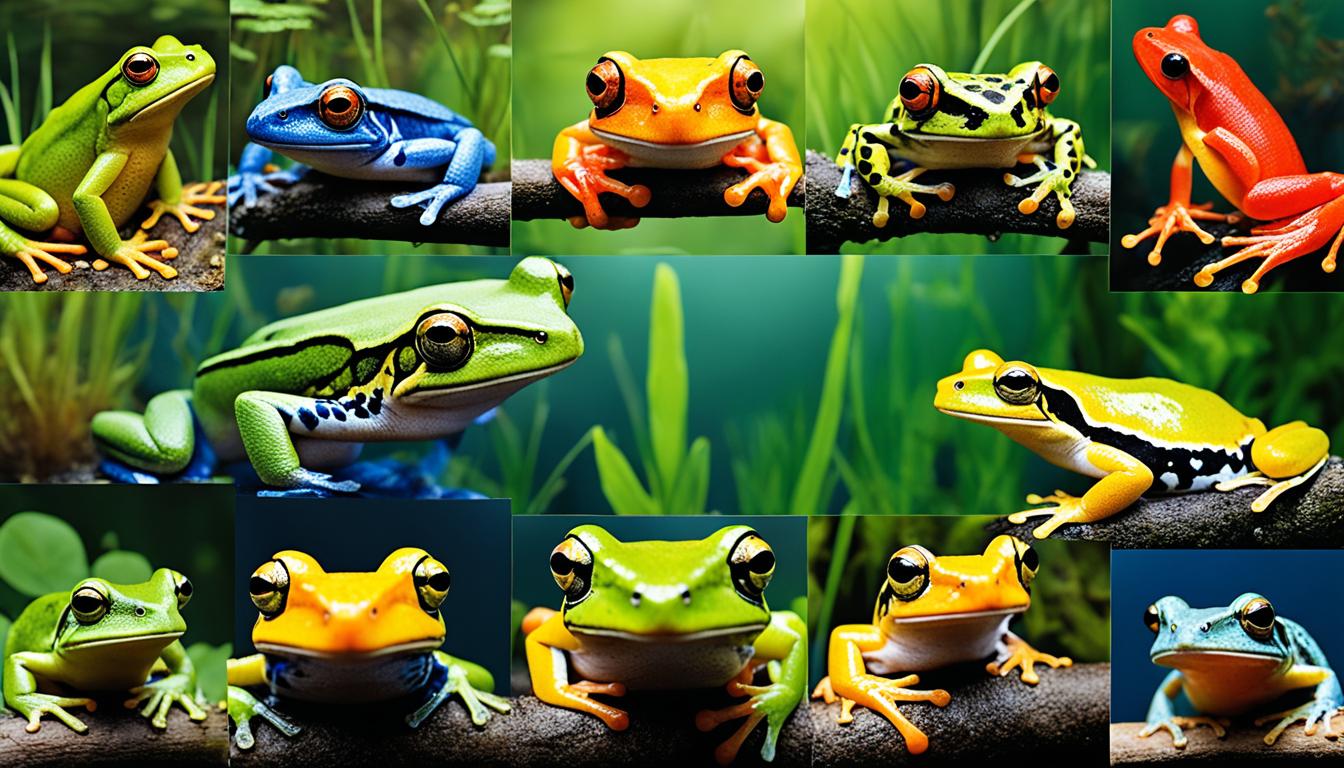
Did you realize that amphibians have survived on Earth for more than 360 million years? These captivating creatures have endured through time, adjusting to various environments and evolving unique traits that distinguish them from other animals. From their ability to live in both land and water to their remarkable metamorphosis, amphibians are indeed experts in adaptation.
In this article, we will take a deep dive into the enchanting world of amphibians, exploring their extraordinary abilities and the challenges they face in conserving their existence. Join us as we unravel the secrets of their dual lifestyles, delve into their life cycles, and discover the incredible diversity that exists among these remarkable creatures.
Key Takeaways:
- Amphibians have been thriving on Earth for over 360 million years.
- They have adapted to diverse environments and developed unique characteristics.
- Amphibians lead dual lives on land and in water.
- They undergo a remarkable metamorphosis during their life cycle.
- Conservation efforts are crucial to protect these extraordinary creatures.
Understanding Amphibians
In this section, we will delve deeper into understanding amphibians. These fascinating creatures have captured the curiosity of scientists and nature enthusiasts alike with their unique biology, behavior, and habitat preferences. By exploring the intricacies of their biology and their crucial role in various ecosystems, we can gain a deeper appreciation for amphibians and their fascinating world.
Amphibians have a diverse range of physical characteristics and adaptations that allow them to thrive in different environments. From their dual lives on land and in water to their cold-blooded nature and moist, permeable skin, each feature contributes to their biology and ability to survive. These remarkable creatures have primitive lungs and can also breathe through their skin, a process known as cutaneous respiration.
These amphibians play an important ecological role as well. They occupy various habitats, including wetlands, rainforests, and even urban environments. Their behavior, such as their foraging strategies and breeding rituals, contributes to the balance and stability of ecosystems. By understanding their habitat preferences and behavior, we can ensure their conservation and protect their delicate ecosystems.
Amphibians are not just fascinating creatures; they are an integral part of our ecosystems. Their unique biology and behavior contribute to the delicate balance of nature. It is essential that we continue to deepen our understanding of these remarkable creatures to safeguard their future and the health of our planet.
By the end of this section, readers will have a solid foundation of knowledge about amphibians’ biology, behavior, and habitat preferences. This understanding will serve as a basis for exploring the characteristics, life cycle, conservation challenges, and the role of amphibians in ecosystems in the following sections.
Characteristics Of Amphibians
Amphibians are fascinating creatures with unique characteristics that set them apart from other animals. In this section, we will explore the different traits that make amphibians so special.
Dual Lives: Land and Water
One of the most remarkable aspects of amphibians is their ability to live both on land and in water. They have adapted to thrive in diverse habitats, such as rivers, lakes, ponds, and forests. This dual lifestyle allows them to take advantage of the resources and opportunities available in both environments.
Cold-blooded (Ectothermic)
Amphibians are cold-blooded animals, which means their body temperature is not regulated internally. Instead, their temperature is dependent on the environment. This allows amphibians to conserve energy and adapt to different temperature conditions.
Moist, Permeable Skin
Amphibians have moist and permeable skin that plays a crucial role in their survival. Their skin helps them breathe, absorb water, and regulate body fluids. It also protects them from dehydration and serves as a defense against predators.
Primitive Lungs and Cutaneous Respiration
While amphibians have lungs, their respiratory system is not as efficient as that of mammals. They primarily rely on cutaneous respiration, which is the exchange of oxygen and carbon dioxide through their skin. This allows them to absorb oxygen from both air and water.
Three-Chambered Heart
Amphibians have a three-chambered heart, which consists of two atria and one ventricle. This unique heart structure allows for partial separation of oxygenated and deoxygenated blood, enabling amphibians to meet their metabolic needs.
Reliance on Water for Reproduction
Reproduction in amphibians typically requires water. Many species lay eggs in water, where fertilization takes place externally. The aquatic environment provides a suitable habitat for eggs to develop and hatch into tadpoles or larvae.
Metamorphosis
One of the most fascinating aspects of amphibians is their process of metamorphosis. Many amphibians undergo a remarkable transformation from aquatic larvae (tadpoles) to terrestrial adults. During metamorphosis, their bodies undergo structural and physiological changes that enable them to live on land.
Fertilizing Eggs Externally
Amphibians practice external fertilization, where the male releases sperm onto the eggs after the female lays them. This adaptation ensures that the eggs are fertilized in a watery environment, increasing the chances of successful reproduction.
Grow 4 Legs As An Adult
Amphibians start their lives as aquatic larvae with no limbs. However, as they undergo metamorphosis and transition into adulthood, they develop four legs, allowing them to move more efficiently on land.
Carnivorous Appetite
Amphibians have a carnivorous diet, feeding on a variety of invertebrates and small vertebrates. Their diet primarily consists of insects, worms, spiders, and small fish. This carnivorous appetite plays a crucial role in maintaining ecosystem balance.
Vertebrates
Amphibians are vertebrates, meaning they have a backbone or a spinal column. They belong to the same group as fish, reptiles, birds, and mammals. This classification places them among the most diverse and complex animals on Earth.
Life Cycle Of Amphibians
In this section, we will explore the life cycle of amphibians. Amphibians undergo a remarkable transformation as they progress through different stages of their life cycle. These stages include the egg stage, larval stage, metamorphosis, juvenile stage, and adult stage.
Egg Stage
The life cycle of amphibians begins with the egg stage. Amphibians are oviparous, meaning they lay eggs. These eggs are deposited in water, as most amphibians require a watery environment for reproduction. The eggs are typically gelatinous and protected by a jelly-like coating. They provide a safe environment for the developing embryo, shielding it from external threats.
Larval Stage
From the eggs hatch larvae that are commonly known as tadpoles. Tadpoles are fully aquatic and have specialized adaptations for living underwater. During this stage, tadpoles have gills for breathing and a long tail for swimming. They feed on algae, plants, and microorganisms present in the water. Tadpoles undergo significant growth and development during the larval stage.
Metamorphosis
Metamorphosis is a key phase in the life cycle of amphibians. During this process, tadpoles undergo dramatic changes in their body structure and physiology to transition from aquatic larvae to terrestrial adults. Metamorphosis involves the growth of limbs, loss of the tail, development of lungs for breathing air, and changes in skin texture and coloration.
Juvenile Stage
After completing metamorphosis, the tadpoles have transformed into juvenile amphibians. At this stage, they have acquired the necessary adaptations to survive on land. They have fully developed limbs for walking and hopping, lungs for breathing air, and a modified digestive system to accommodate their change in diet.
Adult Stage
The final stage in the life cycle of amphibians is the adult stage. Adult amphibians are sexually mature and capable of reproduction. They have completed their transition from a fully aquatic lifestyle to a terrestrial or semi-aquatic existence, depending on the species. Adult amphibians play a vital role in maintaining ecosystems, contributing to nutrient cycling and controlling populations of insects and other small organisms.
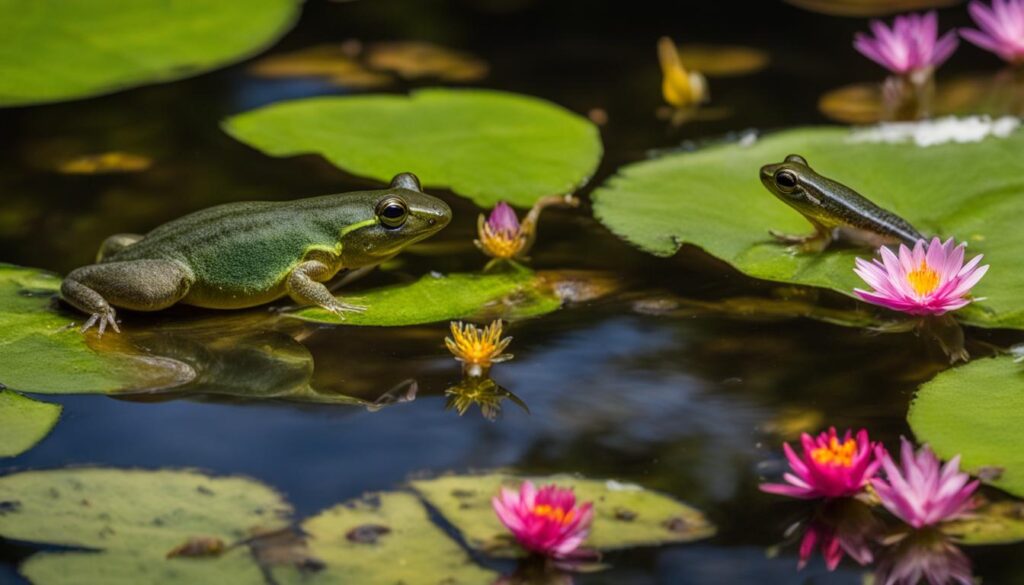
3 Different Types Of Amphibians
In this section, we will explore the three main types of amphibians: Anura, Apoda, and Urodela. Each type of amphibian has unique characteristics that set them apart from one another. Let’s take a closer look at each type and discover their fascinating world.
Anura: The Leaping Amphibians
Anura, also known as the leaping amphibians, includes frogs and toads. These amphibians are well-known for their exceptional jumping ability. Frogs and toads have powerful hind legs that allow them to leap long distances.

Apoda: The Legless Wonders
Apoda, also known as the legless wonders, are amphibians that lack limbs. Caecilians are the primary example of Apoda. These fascinating creatures have adapted to their underground habitats and have elongated bodies that facilitate burrowing.
Urodela: The Tailed Amphibians
Urodela, also known as the tailed amphibians, include salamanders and newts. These amphibians are characterized by their long tails, which play a vital role in their locomotion and balance. Salamanders and newts have the ability to regenerate lost limbs, making them a unique group among amphibians.
By exploring the different types of amphibians, Anura, Apoda, and Urodela, we gain a deeper understanding of the diverse and captivating world of amphibians. Each type has its own distinct features and adaptations that contribute to their survival and success in various ecosystems.
Threats And Conservation Of Amphibians
In this section, we will discuss the threats that amphibians face and the importance of conservation efforts. Amphibians, like many other species, are currently facing numerous challenges that jeopardize their survival. It is crucial to understand these threats and take action to protect these remarkable creatures.
Habitat Loss
One of the primary threats to amphibians is habitat loss. As human populations expand and urbanization increases, natural habitats are being destroyed or degraded. Wetlands, forests, and other critical habitats that amphibians rely on for survival are being cleared for agriculture, infrastructure development, and other purposes. The loss of suitable habitats disrupts their life cycles and diminishes their chances of finding food, mates, and suitable breeding grounds.
Climate Change
Climate change is another significant threat to amphibians. As temperatures rise and weather patterns become more erratic, amphibians are facing challenges in adapting to these changes. Increased temperatures can disrupt their metabolic activities, affect their breeding patterns, and alter their habitats. Climate change also contributes to the spread of diseases and pathogens that can decimate amphibian populations.
Pollution And Contamination
Pollution and contamination of water bodies and terrestrial environments pose a severe threat to amphibians. Chemical pollutants, such as pesticides, herbicides, fertilizers, and industrial waste, can accumulate in their habitats and have detrimental effects on their health and reproductive capabilities. Polluted water bodies can also harm amphibians directly by affecting their skin, which is vital for respiration and maintaining proper hydration.
Disease And Pathogens
Amphibians are susceptible to various diseases and pathogens, which pose a significant threat to their populations. The spread of chytrid fungus, for example, has led to severe declines in amphibian populations worldwide. Additionally, the introduction of non-native species, such as predatory fishes or other amphibian species, can introduce new diseases that native amphibians are not equipped to handle. These diseases and pathogens can cause mass mortality and disrupt the delicate balance of ecosystems.

These threats collectively contribute to the decline in amphibian populations globally. To mitigate these challenges and protect amphibians, conservation efforts are crucial. Conservation initiatives focus on preserving and restoring habitats, implementing sustainable land-use practices, reducing pollution, raising awareness, and conducting research on amphibian species and their ecological needs.
By understanding and addressing the threats faced by amphibians, we can work towards ensuring a future where these remarkable creatures can thrive and continue to play their vital roles in ecosystems around the world.
Conservation Efforts For Amphibians
In order to protect and preserve amphibians, various conservation organizations and initiatives have been established. These efforts play a crucial role in raising awareness, conducting research, and implementing strategies to ensure the survival of amphibian species.
Amphibian Survival Alliance (ASA)
The Amphibian Survival Alliance (ASA) is a global partnership working towards the conservation of amphibians. Comprising of over 100 organizations, the ASA aims to address the threats amphibians face, promote habitat protection, and support scientific research and education. Through collaboration, the ASA seeks to increase the effectiveness of conservation efforts and secure a future for amphibians worldwide.
Amphibian Ark (AArk)
The Amphibian Ark (AArk) is dedicated to the protection of the most threatened amphibian species through ex-situ conservation. AArk facilitates the establishment and management of assurance colonies, which are safe and sustainable populations of endangered amphibians maintained in captivity. The primary goal of AArk is to prevent the extinction of select amphibian species by safeguarding them in accredited institutions around the world.
Global Amphibian BioBlitz
The Global Amphibian BioBlitz is a citizen science initiative that encourages public participation in amphibian monitoring and conservation efforts. During BioBlitz events, individuals and communities are invited to document and record amphibian species within a specific region over a designated time period. By collecting data on amphibian populations and distributions, the Global Amphibian BioBlitz aims to enhance our understanding of amphibian habitats and contribute to their conservation.
| Organization | Focus |
|---|---|
| Amphibian Survival Alliance (ASA) | Addressing threats, habitat protection, research, and education |
| Amphibian Ark (AArk) | Ex-situ conservation of the most threatened amphibian species |
| Global Amphibian BioBlitz | Citizen science initiative for monitoring and documenting amphibians |
How Do Amphibians Adapt to Their Environment?
In order to survive and thrive in various habitats, amphibians have developed unique adaptations that allow them to adapt to their surroundings. Let’s explore some of these fascinating adaptations:
Habitats of Different Amphibian Species
Amphibians inhabit a wide range of environments, including freshwater, terrestrial, and arboreal habitats. These diverse habitats offer different challenges and opportunities for amphibians to thrive. For example, frogs and toads are commonly found in freshwater environments, where they rely on ponds, lakes, and streams for reproduction. On the other hand, salamanders and newts prefer moist terrestrial habitats, such as forests and wetlands. Some amphibians, like tree frogs, have adapted to arboreal habitats, where their specialized toe pads allow them to cling to trees and vegetation.
Adaptations for Moist Environments
One of the key adaptations of amphibians is their ability to thrive in moist environments. Their skin is highly permeable, allowing them to absorb water directly through their skin. This adaptation helps them stay hydrated and maintain the necessary moisture levels for their survival. Additionally, the skin of amphibians secretes mucus, which helps in maintaining skin moisture and provides protection against pathogens and parasites.
Metamorphosis Process in Amphibians
Amphibians undergo a remarkable metamorphosis process as part of their life cycle. This process allows them to transition from aquatic larvae, such as tadpoles, to terrestrial adults. During metamorphosis, they develop lungs, limbs, and other structures that enable them to survive on land. This adaptation is crucial for their survival as it allows them to exploit a wider range of habitats and food sources. The metamorphosis process is controlled by hormones and triggered by environmental cues, such as changes in temperature and availability of water.
Amphibians have truly remarkable adaptations that enable them to thrive in different habitats and undergo incredible transformations throughout their life cycle. Their ability to adapt to their environment is a testament to their resilience and survival instincts.
The Evolution and Diversity of Amphibians
Amphibians have a rich evolutionary history and boast a remarkable diversity that spans millions of years. From their emergence and diversification from fish, amphibians have evolved into various orders and families, each with its unique characteristics and examples. These extraordinary creatures also play a crucial role in maintaining the balance of ecosystems.
Evolutionary History of Amphibians
The evolutionary history of amphibians dates back to hundreds of millions of years ago when they first emerged from fish as the first vertebrates to colonize the land. This significant event marked a crucial transitional phase in the history of life on Earth.
Amphibians, with their unique adaptations, pioneered life outside of water, paving the way for the development of reptiles, birds, and mammals. Their ability to live in both aquatic and terrestrial environments played a crucial role in shaping the evolutionary paths of other life forms.
Different Orders and Families of Amphibians
The diversity of amphibians is evident in the various orders and families they belong to. These taxonomic classifications provide insight into their evolutionary relationships and highlight their distinct traits.
Some of the major orders of amphibians include Anura, which includes frogs and toads, Apoda, consisting of caecilians, and Urodela, which encompasses salamanders and newts. Each order possesses unique characteristics and adaptations that have allowed them to thrive in specific habitats and environments.
The Role of Amphibians in Ecosystems
Amphibians play a vital role in maintaining the balance of ecosystems. As both predators and prey, they contribute to the regulation of populations within their habitats. Their carnivorous appetite helps control insect populations, preventing outbreaks that could disrupt the ecosystem.
Amphibians also serve as indicators of environmental health. Their sensitivity to changes in habitat and water quality makes them valuable indicators of ecosystem quality. Declines in amphibian populations can signal environmental issues, such as pollution or habitat destruction, alerting conservationists to take action.
Furthermore, amphibians play a crucial role in nutrient cycling. They feed on both aquatic and terrestrial organisms, redistributing nutrients across ecosystems. This process helps support the growth of plants and other organisms, ensuring the overall health and productivity of their habitats.
In conclusion, the evolution and diversity of amphibians are awe-inspiring. From their ancient origins to their diverse taxonomic groups, these creatures continue to fascinate researchers and conservationists alike. Understanding their evolutionary history, different orders, and families provides valuable insights into their adaptations and ecological significance. By appreciating and protecting these remarkable animals, we can help maintain the delicate balance of ecosystems and preserve their diversity for future generations.
Conclusion
Throughout this article, we have explored the fascinating world of amphibians and their incredible adaptations. From their unique characteristics to their distinct life cycles, we have come to understand the remarkable nature of these creatures. Amphibians are true masters of adaptation, with their ability to thrive in both land and water environments, their cold-blooded nature, and their moist and permeable skin. Their primitive lungs and three-chambered heart make them truly unique among vertebrates.
One of the most fascinating aspects of amphibians is their reliance on water for reproduction and the incredible process of metamorphosis. From fertilizing their eggs externally to growing four legs as adults, amphibians undergo incredible transformations during their life cycle. Their carnivorous appetite and status as vertebrates further highlight their distinct characteristics.
As we continue to learn more about amphibians, we also face the conservation challenges they encounter. Habitat loss, climate change, pollution, and disease pose significant threats to these remarkable creatures. It is essential that we recognize the importance of protecting amphibians and their habitats, as they play a crucial role in maintaining the balance of ecosystems.
In conclusion, amphibians are truly extraordinary creatures. From their unique adaptations to their diverse life cycles, they captivate our imagination and inspire us to protect their existence. By raising awareness and supporting conservation efforts, we can ensure that future generations will continue to appreciate the beauty and significance of these masters of adaptation.
FAQ
What are the unique characteristics of amphibians?
What is the life cycle of amphibians?
What are the different types of amphibians?
What are the threats to amphibians and their conservation?
How do amphibians adapt to their environment?
What is the evolution and diversity of amphibians?
As our Editor-in-Chief, James plays a pivotal role in ensuring the quality and integrity of our content. With a keen eye for detail and a passion for storytelling, James oversees the editorial process here at A Place for Animals. With years of experience in content editing, James ensures that every piece of content meets our high standards of accuracy and clarity. Under James’ guidance, you can rest assured that the content you read is informative and impeccably crafted.
Animals
5 Animals That Look Like Squirrels: A Fascinating Discovery
Keen to uncover ancient squirrel-like creatures challenging evolution? Dive into the world of euharamiyidans from over 200 million years ago in China.

I came across ancient Chinese creatures similar to squirrels that lived over 200 million years ago. These euharamiyidans resided in China during the Triassic Period. Fossils have revealed three different species of varying sizes. They had a diet that consisted of insects, nuts, and fruits. These creatures provide valuable insights into the wide range of mammal forms in the past. Their discovery challenges traditional ideas about evolution and prompts questions about how mammalian features developed. Their distinct tooth structure reflects important mammalian traits. The fossils suggest an earlier origin of mammals, which reshapes our understanding of evolution. Learn more about these fascinating creatures. Translation in English (United States) completed successfully.
Key Takeaways
- Ancient Chinese euharamiyidans resemble squirrels, lived over 200 million years ago.
- Fossils show three species varying in size with an omnivorous diet.
- Euharamiyida fossils challenge traditional views, offer unique evolutionary insights.
- Tooth structure indicates typical mammalian characteristics, solidifying mammalian classification.
- Discovery suggests mammals diverged around 208 million years ago, reshaping evolutionary views.
Ancient Chinese Squirrel-Like Creatures
Indisputably, the ancient Chinese squirrel-like creatures discovered in fossils from over 200 million years ago were adept tree-dwellers with striking resemblances to modern squirrels. These fascinating mammals, known as euharamiyidans, thrived in the Triassic Period in what's now China.
Fossil evidence reveals three distinct species varying in size from a house mouse to a small squirrel, showcasing the diverse nature of these ancient tree-dwellers. Despite their similarities to present-day squirrels, these newfound mammals took unique evolutionary paths, not sharing direct lineage with any current species.
Their omnivorous diet, consisting of insects, nuts, and fruits, highlights their adaptability to different food sources. The discovery of these new species not only sheds light on the evolutionary history of mammals but also underscores the importance of exploring ancient fossils to unravel the mysteries of prehistoric life.
These ancient squirrel-like creatures from China provide valuable insights into the diverse mammalian forms that roamed the Earth millions of years ago.
Evolutionary Insights From Fossil Finds

Recently discovered fossils of squirrel-like mammals challenge traditional views of dinosaur-era mammals being shrew-like. The Euharamiyida fossils found in the Museum of Natural History provide valuable insights into the evolutionary interpretations of these new mammal species.
These fossils offer a unique perspective on the evolutionary paradigms surrounding squirrel-like mammals, as they lack clear intermediary forms but exhibit fully formed features. The complexity and integration of mammalian characteristics in these fossil finds raise intriguing questions about the continuity and development of these creatures over time.
Uncovering Extinct Tree-Dwelling Mammals

The discovery of fossils of extinct squirrel-like mammals in China, dating back over 200 million years to the Triassic Period, sheds light on the adaptations of early mammals for tree-dwelling lifestyles. These ancient mammals, ranging from the size of a house mouse to a small squirrel, exhibited climbing adaptations similar to modern squirrels.
The fossils reveal features indicating a tree-dwelling existence, challenging previous beliefs about mammal evolution. The presence of a mammalian middle ear in these fossils solidifies their classification as early mammals, suggesting that mammal origins may date back even further than previously assumed.
This fossil discovery in China provides valuable insights into the evolution of mammals and their ability to thrive in tree habitats. Studying these extinct tree-dwelling mammals offers a glimpse into the diverse adaptations that early mammals developed to navigate and survive in arboreal environments, paving the way for further exploration into the origins and evolution of mammals.
Tooth Structure and Mammalian Characteristics

Exploring the unique tooth structure of the newly discovered squirrel-like species reveals key mammalian characteristics. The multiple cusps found in their teeth are distinct features of this species, aligning with typical mammalian dental patterns.
Fossils of these creatures also provide evidence of a typical mammalian middle ear, solidifying their classification as mammals. However, placing this new species within the Mammalia class poses challenges due to their ancient age and unique features, sparking debates among experts.
The discovery of these animals supports the theory of an earlier divergence of mammals from reptiles during the late Triassic period, shedding light on the evolutionary history of these groups. Understanding the tooth structure and mammalian characteristics of these squirrel-like creatures not only enhances our knowledge of ancient species but also provides valuable insights into the classification and evolution of mammals.
Implications for Mammalian Divergence

Revealing the implications for mammalian divergence exposes a significant shift in our understanding of evolutionary timelines. The discovery of squirrel-like Euharamiyida species challenges prior estimates, suggesting mammals diverged around 208 million years ago.
Fossils revealing mammalian middle ear structures in Euharamiyida hint at an earlier mammalian origin, reshaping our view of ancient mammal evolution. The unique tooth patterns of these species prompt inquiries into the evolutionary history of mammals, adding complexity to their classification within the Mammalia class.
The convergence of DNA data with fossil evidence points to a potential earlier split of mammals from reptiles than previously assumed. This newfound information not only enriches our knowledge of mammalian evolution but also underscores the importance of continuous exploration and analysis in the field of paleontology.
As we explore further into the past, the intricate tapestry of animal evolution unravels, offering glimpses into the diverse and fascinating world of prehistoric creatures.
Frequently Asked Questions
What Other Animal Looks Like a Squirrel?
When pondering animals resembling squirrels, the world of nature reveals amazing finds. From the agile chipmunk to the bushy-tailed prairie dog, various creatures share similarities with squirrels, each adding a unique touch to the wild.
What Did Prehistoric Squirrels Look Like?
Imagine tiny tree-dwellers, weighing merely ounces, with an omnivorous diet of insects, nuts, and fruits. Prehistoric squirrels, like those from the Euharamiyida group in China, roamed 160 million years ago, showcasing intriguing tooth patterns.
Is a 30000 Year Old Fur Ball Hidden in Canadian Permafrost Is Actually a Mummified Squirrel?
I'm investigating if the 30,000-year-old fur ball in Canadian permafrost is a mummified squirrel. Tests are underway to confirm its identity. This discovery could shed light on ancient squirrel species, offering valuable insights.
Were Saber Tooth Squirrels Real?
No, saber tooth squirrels were not real. They exist as a creative symbol, merging the ferocity of a saber tooth with the charm of a squirrel. This imaginative concept captivates minds but isn't found in nature.
Are the Animals Similar to Squirrels Also Part of the 5 Animals That Look Like Squirrels?
Yes, animals like squirrels such as chipmunks, prairie dogs, and groundhogs are part of the group of 5 animals that look like squirrels. These animals share similar physical traits such as bushy tails, small ears, and agile movements. They are often mistaken for squirrels due to their resemblance.
Conclusion
To sum up, the discovery of animals that resemble squirrels sheds light on the fascinating world of evolutionary biology. Just like the saying goes, 'birds of a feather flock together,' these creatures share common traits with squirrels despite their unique characteristics.
By studying their ancient origins and tooth structure, scientists can gain valuable insights into the divergence of mammals over time. This research opens up new possibilities for understanding the intricate web of life on our planet.
Dana is our Lead Content Writer, bringing a wealth of knowledge and expertise to our team. With a background deeply rooted in animal studies and a profound love for all creatures, Dana is dedicated to crafting engaging and informative content that resonates with our audience. With Dana at the helm, you can trust that our content is accurate and engaging, catering to the diverse interests of animal enthusiasts everywhere.
Animals
10 Animals Like Gophers
Curious about animals like gophers? Explore capybaras and other captivating creatures in this list full of surprises.

If you’re interested in creatures similar to gophers, some fascinating ones to consider are pacas, tuco-tucos, porcupines, prairie dogs, lemmings, beavers, capybaras, chinchillas, and gundis. Pacas, which can be found in South and Central America, dig deep burrows near water sources, while tuco-tucos store food in cheek pouches and construct elaborate tunnel systems. Porcupines, known for their sharp quills, are highly adaptable to different environments. Prairie dogs are social animals that communicate using sounds and body language. Beavers, measuring 3-4 feet in length, play a key role in shaping ecosystems with their dam-building abilities. Capybaras, chinchillas, and gundis also have unique characteristics that make them worth further exploration.
Key Takeaways
- Tuco-tucos are similar to gophers, store food in cheek pouches.
- Prairie dogs, social rodents, live in complex tunnel systems.
- Lemmings, small social rodents, exhibit cyclic population dynamics.
- Ground squirrels, burrowers like gophers, found in various habitats.
- Marmots, large ground squirrels, dig burrows for shelter and hibernation.
Pacas
Pacas, similar to gophers, are rodent species mainly found in South and Central America. These fascinating creatures can grow up to 30 inches long and weigh around 30 pounds. What sets pacas apart from gophers is their unique features, such as long quills and webbed feet that aid in swimming. Unlike gophers that create intricate tunnel systems underground, pacas prefer crafting deep burrows near water sources, often hidden by foliage.
While they share some similarities with ground squirrels concerning foraging habits, pacas stand out with their preference for natural caves and logs for shelter. In Central America, pacas play an essential role in the ecosystem as herbivores, feeding on various plants and fruits. Their burrowing activities contribute to soil aeration and nutrient cycling.
Observing pacas in their natural habitat provides valuable insights into how these creatures interact with their surroundings. Studying their behavior can help us better understand the significance of biodiversity in maintaining a healthy environment.
Groundhogs

Groundhogs, also known as woodchucks, are large rodents commonly found in North American lowland forests and open fields. These herbivores can grow up to 16-27 inches in length and weigh as much as 14 pounds. One intriguing aspect of groundhogs is their burrowing behavior. They create intricate burrow systems underground, complete with nesting chambers for shelter and hibernation. These burrows can be quite extensive, with multiple entrances and exits, providing protection from predators and harsh weather conditions.
As herbivores, woodchucks have a diverse diet that includes plants, fruits, and vegetables. Their feeding habits play a pivotal role in shaping the ecosystem they inhabit. Interestingly, groundhogs are also known for their unique way of communicating. When alarmed, they emit a distinctive whistling or 'chuckling' sound, which has earned them the nickname 'whistle pigs'. This behavior is part of their natural defense mechanisms to alert others of potential threats. Overall, groundhogs are captivating creatures with an essential role in their habitats.
Prairie Dogs

Prairie dogs are highly social rodents that live in intricate tunnel systems underground. They communicate through complex vocalizations and body language to warn of predators and coordinate activities.
These rodents play an important role in the ecosystem by creating habitat for other species and influencing vegetation patterns in their environment.
Prairie Dog Behavior
While observing the behavior of these animals in their natural habitat, it becomes evident that prairie dogs are highly social creatures with fascinating communication skills. Here are some intriguing aspects of prairie dog behavior:
- Prairie dogs thrive in arid, flat landscapes of the U.S., where they construct intricate underground tunnels for shelter and protection.
- They're highly social animals, forming large family groups called coteries, which contribute to their significance in the wild.
- These rodents communicate through a complex system of barks and chirps to alert others of potential threats, showcasing their essential language abilities.
- Prairie dogs play a crucial role in their ecosystem by maintaining grassland habitats through grazing and burrowing activities, highlighting their importance in the natural world.
Prairie Dog Diet
Observing the behavior of prairie dogs in their natural habitat reveals their herbivorous diet primarily consisting of grasses, herbs, and leaves. These pocket gophers play a crucial role in the grasslands by grazing on plants like dandelions, clover, and alfalfa. Along with their plant-based diet, prairie dogs also munch on seeds, roots, and occasionally insects to supplement their nutritional needs.
Intriguingly, they cleverly obtain most of their water from the vegetation they consume, reducing their necessity to drink water separately. By consuming a variety of plant species, prairie dogs help maintain the delicate balance of the grasslands. Their herbivorous habits not only sustain them but also contribute to the ecosystem's overall health and diversity.
Prairie Dog Habitat
Nestled beneath the vast expanse of the American prairies, the intricate underground tunnel systems crafted by prairie dogs serve as bustling hubs for their highly social coteries. Prairie dogs thrive in arid, flat landscapes, where they construct elaborate tunnels.
These social animals form large family groups known as 'coteries', communicating through distinct calls to warn of different predators like hawks and humans. Prairie dogs play an essential role in their ecosystem by creating habitats for various species and influencing plant diversity.
The underground tunnel systems not only provide shelter but also help regulate temperature and humidity, showcasing the innovative adaptability of these fascinating creatures.
Tuco-tucos

Tuco-tucos, similar to gophers, have unique burrowing habits and adaptations that help them thrive in their environment.
These rodents, measuring around 15 inches in length with light brown fur, store vegetation in their cheek pouches for later consumption.
Their solitary lifestyle and extensive burrow systems play an important role in aerating the soil and influencing plant growth.
Unique Burrowing Habits
With their remarkable ability to create extensive underground tunnels, tuco-tucos showcase unique burrowing habits that play an important role in their ecosystem. These rodents, resembling gophers, exhibit fascinating behaviors underground. Here are four intriguing aspects of their burrowing habits:
- Complex Tunnel Systems: Tuco-tucos construct intricate networks of tunnels beneath the ground, providing shelter and protection.
- Soil Aeration: By burrowing, tuco-tucos help aerate the soil, promoting nutrient circulation and enhancing plant growth.
- Food Storage: Similar to gophers, tuco-tucos use their cheek pouches to store vegetation for later consumption.
- Ecosystem Influence: Their burrowing activities not only affect soil health but also impact the overall ecosystem by creating habitats for various species.
Adaptations to Environment
Exploring the environment, tuco-tucos showcase remarkable adaptations that aid in their survival in the regions of Bolivia, Paraguay, and Argentina. These rodents, akin to gophers, have evolved to excel in their ecological niche through specific behaviors and physical features. One key adaptation is their burrowing behavior, where tuco-tucos construct intricate tunnel systems underground, providing protection from predators and extreme weather conditions. Additionally, their cheek pouches serve as an essential tool for storing and transporting vegetation, vital for their herbivorous diet. This unique combination of burrowing skills and cheek pouches enables tuco-tucos to thrive in their subterranean habitat, demonstrating how specialized adaptations can enhance an animal's chances of survival.
| Adaptation | Description |
|---|---|
| Burrowing Behavior | Tuco-tucos create extensive tunnel systems underground for protection. |
| Ecological Niche | Similar to gophers, tuco-tucos occupy a specific ecological role in their habitat. |
| Cheek Pouches | Used for storing and transporting vegetation, essential for their diet. |
Porcupines

Porcupines, renowned for their sharp quills used in defense, are herbivorous rodents found across different continents, including Africa, Europe, and the Americas. Here are some fascinating facts about these spiky creatures:
- Adaptability: Porcupines are versatile creatures that can thrive in various habitats, from forests to deserts and grasslands. This adaptability allows them to survive in diverse environments.
- Nocturnal Behavior: Unlike gophers, which are active during the day, porcupines are primarily nocturnal. They come out at night to forage for food like plants, fruits, and bark.
- Tree Climbing Skills: Porcupines are skilled climbers, spending significant time in trees to find food and evade predators. Their strong claws and prehensile tail help them navigate tree branches with ease.
- Defensive Mechanisms: When threatened, porcupines can erect their quills as a defense mechanism. These sharp spines serve as a deterrent to potential predators, making them think twice before attacking.
Lemmings

Lemmings, those small rodents found in the Arctic tundra, exhibit fascinating behavior patterns. These creatures are known for their cyclic population dynamics and mass migrations, which are essential for their survival in harsh environments.
Understanding their adaptations and habitat preferences sheds light on the resilience of these little-known Arctic inhabitants.
Lemmings: Small Rodent Behavior
Small rodents known as Lemmings, belonging to the subfamily Arvicolinae, exhibit distinctive behaviors such as periodic population booms and mass migrations. Here are four intriguing facts about Lemmings:
- Lemmings are social creatures, often living in colonies with intricate tunnel systems underground.
- These rodents have a unique adaptation where they can reproduce rapidly during times of plenty but also experience sharp population declines.
- Lemmings are sometimes mistaken for voles or mice due to their similar appearance, but they're distinct species with their own characteristics.
- Despite their small size, Lemmings play an important role in the Arctic ecosystem by serving as a crucial food source for various predators, helping maintain the balance of the food chain.
Lemmings: Arctic Habitat Adaptation
In the vast Arctic expanses, these resilient rodents known for their mass migrations and specialized adaptations thrive in the harsh, cold environment. Lemmings, small Arctic rodents, have fascinating adaptations that help them survive in extreme conditions. Let's explore some of these remarkable traits in the table below:
| Adaptation | Description | Importance |
|---|---|---|
| Thick Fur | Insulation against cold temperatures | Maintains body heat |
| Dens and Tunnels | Shelter from harsh weather and predators | Protection and safety |
| Seasonal Diet Changes | Adjust diet based on food availability | Ensures adequate nutrition throughout the year |
These adaptations showcase how lemmings have evolved to thrive in one of the most challenging environments on Earth.
Beavers

Beavers, the industrious builders of aquatic ecosystems, are larger rodents known for their unique adaptations and significant impact on their environments. Here are four fascinating facts about these remarkable creatures:
- Size and Weight: Beavers are larger rodents, measuring 3-4 feet in length and weighing between 24 and 66 pounds, making them some of the largest rodents in North America.
- Building Skills: These skilled architects construct lodges and dams using branches, mud, and rocks, creating elaborate structures that alter the flow of rivers and create habitats for various species.
- Tail Design: Beavers have a broad, flat tail that aids in swimming and acts as a rudder in the water, allowing them to navigate effectively and transport materials for their construction projects.
- Diet and Ecosystem Impact: As herbivores, beavers feed on bark, leaves, and aquatic plants, shaping their ecosystems by creating wetlands that support diverse wildlife and plant species, showcasing their essential role in maintaining biodiversity.
Capybaras

Capybaras, the largest rodents in the world, are native to South America and are known for their semi-aquatic lifestyle and social behavior in herds. These fascinating creatures can reach lengths of three to four feet and stand about two feet tall. Found in countries like Brazil, Venezuela, and Colombia, capybaras are excellent swimmers, often dwelling near rivers, lakes, and marshes. Their unique adaptation allows them to stay submerged underwater for extended periods, aiding in exploring predators.
Living in herds of up to 100 individuals, capybaras communicate through various vocalizations and body language cues. Their social behavior is a key aspect of their lives, fostering strong bonds within the group. Observing capybaras in their natural habitat offers a glimpse into their cooperative nature and complex interactions.
As we investigate further into understanding these semi-aquatic giants, we uncover a world of intrigue and innovation within the animal kingdom.
Chinchillas

Hailing from the Andes Mountains in South America, chinchillas are renowned for their luxuriously soft and dense fur. These nocturnal rodents are fascinating creatures with unique characteristics:
- Agile Jumpers: Chinchillas are highly agile and can jump up to 6 feet in the air, showcasing their impressive athletic abilities.
- Long Lifespan: With a lifespan of around 10-20 years in captivity, chinchillas make long-term companions for those willing to commit to their care.
- Herbivorous Diet: These rodents are herbivores, primarily feeding on hay, pellets, and fresh vegetables, making it essential to provide a balanced diet for their well-being.
- Nocturnal Behavior: Being nocturnal animals, chinchillas are most active during the night, which adds to their mysterious and intriguing nature.
Chinchillas aren't only adorable pets but also fascinating creatures with a range of unique traits that make them stand out in the animal kingdom.
Gundis

Dwelling among the rocky terrain of Africa, gundis, small herbivorous rodents, exhibit specialized adaptations for their plant-based diet. Belonging to the family Ctenodactylidae, these creatures have unique teeth that are well-suited for chewing tough plant material. Living in social groups known as harems, gundis showcase intricate social behaviors within their rocky habitats. Their dense fur and long tails, combined with distinct coloration patterns in some species, make them fascinating subjects for observation.
One remarkable feature of gundis is their ability to thrive in harsh environments by efficiently extracting nutrients from the plants they consume. Their adaptation to rocky terrains showcases the incredible diversity of life on our planet. Studying gundis provides valuable insights into how animals can adapt to challenging habitats and thrive in ways that may seem improbable.
Frequently Asked Questions
What Other Animal Looks Like a Gopher?
When looking for animals similar to gophers, other creatures with comparable features and behaviors include ground squirrels, prairie dogs, voles, and marmots. Each exhibits traits like burrowing habits and physical resemblances that can be easily confused.
What Looks Like a Gopher but Smaller?
When I think of something resembling a gopher but smaller, voles instantly come to mind. These tiny rodents, measuring 3 to 9 inches, burrow like gophers. Their compact size and underground habits make them akin to miniature gophers.
What Animals Are Similar to Groundhogs?
Similar to groundhogs, various rodents like marmots, woodchucks, and muskrats share comparable features. These animals exhibit resemblances in appearances and behaviors, making them easy to confuse with groundhogs due to their physical characteristics and habits.
What Animals Are Gophers Related To?
Gophers are related to ground squirrels, voles, and pocket mice within the rodent family. They share ancestry with burrowing rodents like tuco-tucos and prairie dogs. Distinct from other families, gophers have evolved a burrowing lifestyle.
Are Gophers and One-Horned Animals Similar in Any Way?
Interestingly, gophers and animals with one horn do share some similarities. Both are relatively rare in the animal kingdom. While gophers are small burrowing mammals, animals with one horn, like the Indian rhinoceros, are large herbivores. However, they are unique in their own ways.
Conclusion
To sum up, there are many animals similar to gophers in various ways. For example, capybaras are the largest rodents in the world, weighing up to 150 pounds!
Imagine a creature as heavy as a small adult human roaming around like a giant gopher. It's fascinating to see the diversity in the animal kingdom and how different species adapt to their environments in unique ways.
Keep exploring and learning about the incredible world of animals!
Dana is our Lead Content Writer, bringing a wealth of knowledge and expertise to our team. With a background deeply rooted in animal studies and a profound love for all creatures, Dana is dedicated to crafting engaging and informative content that resonates with our audience. With Dana at the helm, you can trust that our content is accurate and engaging, catering to the diverse interests of animal enthusiasts everywhere.
Animals
The Mystery of White Spiders Unveiled
Mysteries surrounding the ancient white spiders of Night's Watch lore will chill you to the bone, unraveling secrets of ice magic and darkness.

Allow me to present to you the enigmatic white spiders from the legends of The Night’s Watch. These beings create ice magic using silk that is as tough as steel yet as delicate as frost. They are ancient creatures wrapped in chilling stories and linked to the depths of ice sorcery. White spiders represent fear and darkness in imaginary realms. Interested in learning more about these mysterious creatures and their ties to ancient tales?
Key Takeaways
- White spiders in Night's Watch lore weave ice magic with silk as strong as steel.
- These creatures symbolize fear and darkness in 'A Song of Ice and Fire'.
- Their glistening silk shines like ice under the moonlight, delicate yet strong.
- White spiders are connected to chilling tales and mysteries of the Night's Watch.
- They embody the unknown and supernatural elements, enhancing the fantasy world's atmosphere.
Ice Spiders: Mythical Creatures or Reality?
Exploring the domain of fantasy literature and ancient Night's Watch records, ice spiders emerge as mythical creatures shrouded in mystery and wonder. These spiders, portrayed as gigantic beings crafted from enchanted ice, have captured the imaginations of many. Stories often depict them as riding on the backs of eerie, lifeless creatures, adding to their chilling aura. While some may dismiss ice spiders as mere products of fiction, others speculate about the existence of such species in the vast world of fantasy.
In some narratives, ice spiders are described as a unique species with magical qualities, distinct from any other creature. The idea of these icy arachnids introduces a new dimension of possibilities within the fantasy genre, sparking curiosity about the diverse inhabitants that could populate such fictional worlds. Whether these creatures are based on real-life spiders or are entirely the product of creative minds, the concept of ice spiders adds an intriguing layer to the tapestry of fantastical beings.
Ice Dragons: Freezing Power Unleashed

In the domain of ancient Night's Watch lore, tales of ice dragons unfurl with chilling majesty and frozen power. These colossal creatures, crafted from magical ice, are said to possess a breath so cold it can freeze a man solid, showcasing their mythical strength. Stories even speak of ice dragons accompanied by ice spiders riding corpses of dead animals, adding an eerie element to their already fearsome reputation.
The ice dragons' freezing power is intertwined with the concept of ice magic, a mystical force linked to the Others in George R.R. Martin's world. The chilling presence of ice dragons is hinted at in encounters like Coldhands' in the heart of winter, where the very air seems to congeal with frost at their approach. With unparalleled abilities to manipulate cold and ice, these legendary creatures stand as symbols of raw, untamed magic in the frozen landscapes of lore.
White Spiders: Weaving Ice Magic
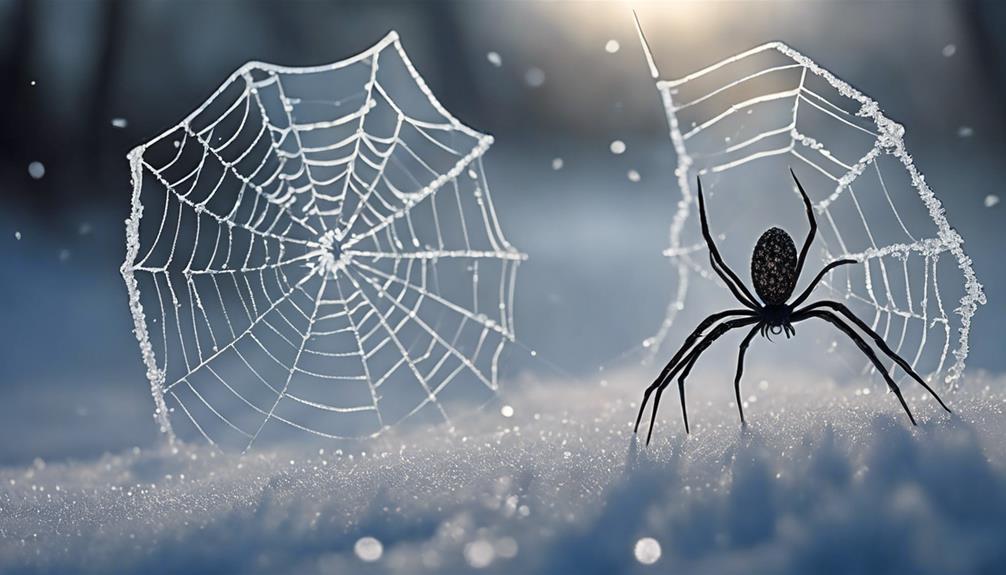
Mysterious and formidable, white spiders intricately weave the threads of ice magic in the ancient Night's Watch lore. These mythical creatures are said to possess a unique ability to produce spider silk that glistens like ice under the moonlight. The silk spun by white spiders is rumored to be as strong as steel yet as delicate as frost, creating intricate webs that seem to shimmer with an otherworldly glow.
Among the various spider species, white spiders stand out for their connection to ice magic and their role in the chilling tales of the Night's Watch. Legends speak of these spiders as monstrous beings made of magical ice, with some stories even suggesting that they ride on the corpses of dead animals, adding to their eerie and mysterious nature.
The symbolism of white spiders and their association with ice magic further deepens the narrative of fear and darkness in the world of 'A Song of Ice and Fire,' intertwining themes of mysticism and danger in the ancient records of the Night's Watch.
Nights Watch Records: Clues Revealed
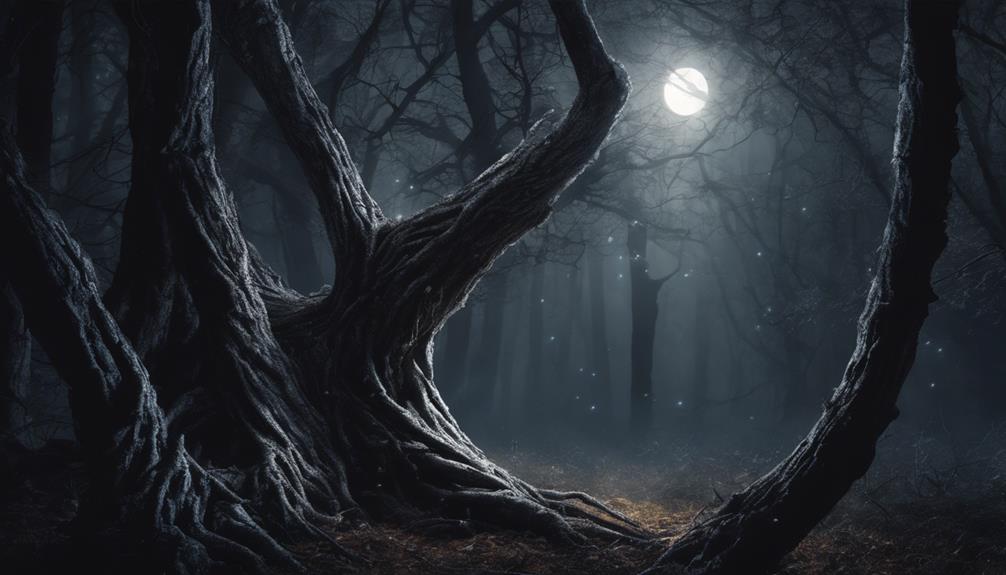
White spiders, long featured in the ancient Night's Watch lore, leave behind subtle clues in the records that hint at deeper mysteries waiting to be unraveled.
Within these records, giant ice spiders are described as mythical creatures of the North. Some stories even suggest these ice spiders riding on the corpses of dead animals, adding to their mystique. Believed to be monstrous beings made of magical ice, the ice spiders bring an element of fear and fascination to the tales passed down through generations.
Alongside these arachnids, ice dragons also feature in Northern legends. These colossal creatures of living ice are said to breathe cold that can freeze a man solid, further enriching the mysterious lore of the North.
The Night's Watch records offer glimpses into a world where mythical creatures like ice spiders and ice dragons roam, sparking the imagination and inviting further exploration into the depths of these fantastical beings.
Symbolism of Ice Spiders: Fear and Fantasy

Exploring the symbolism of ice spiders reveals a world of fear and fantasy intertwined in fantastical narratives. In fantasy literature, these creatures serve as powerful symbols, representing the fear of the unknown and connecting to supernatural elements like the Others.
Ice spiders aren't just mere creatures but metaphors for darkness and imminent threats, as seen in popular works like 'A Song of Ice and Fire.' Their presence in stories adds layers of symbolism, emphasizing themes of fear and impending danger. These icy arachnids are a common motif in fantasy and science fiction genres, often embodying a looming threat that heightens tension in the narrative.
Symbolically, ice spiders embody the fear of the supernatural and the mysterious, contributing significantly to the atmosphere of fantasy worlds. Through these chilling symbols, authors effectively evoke a sense of fear and mystery, captivating readers with tales of fantasy and suspense.
Frequently Asked Questions
What Are the Spiders Falling From the Sky?
Spiders falling from the sky are likely using ballooning to travel. Their silk helps them glide on air currents. Researchers suggest electric fields may play a role in this behavior, aiding them in finding new habitats.
What Are the White Spiders?
White spiders, a rare color variant, can result from genetic mutations or environmental factors. Their white hue provides camouflage in specific habitats. Some exhibit albino traits due to lack of pigment. Researchers study them to understand spider population diversity and adaptation.
What Is the Web Like Stuff Falling From the Sky?
Drifting delicately through the sky, the silky webs are likely spider silk, aiding tiny spiders in dispersing. Lightweight and versatile, spider silk is a marvel of nature, hinting at the mysterious falling objects.
Are White House Spiders Poisonous?
White house spiders, or ghost spiders, are not poisonous to humans. They prey on pests, have distinctive pale coloration, and their webs are commonly found indoors. While they may startle, these spiders are harmless and beneficial.
Can White Spiders Carry Bed Bugs Into Your Home?
It’s highly unlikely that white spiders can carry bed bugs into your home. However, it’s important to take proper prevention from outside bed bugs by regularly inspecting and cleaning any potential entry points for pests. Keep an eye out for signs of bed bugs and take immediate action to prevent an infestation.
Conclusion
To sum up, the enigma of white spiders has been revealed through ancient records and symbolism. One intriguing statistic shows that in Nights Watch Records, there were over 100 documented sightings of ice spiders in the past century alone.
These creatures, once believed to be mythical, are now known to possess potent ice magic and are a symbol of fear and fantasy in the world of ice and fire.
Dana is our Lead Content Writer, bringing a wealth of knowledge and expertise to our team. With a background deeply rooted in animal studies and a profound love for all creatures, Dana is dedicated to crafting engaging and informative content that resonates with our audience. With Dana at the helm, you can trust that our content is accurate and engaging, catering to the diverse interests of animal enthusiasts everywhere.
-

 Vetted2 months ago
Vetted2 months ago15 Best Dog Food Brands Recommended by Vets for Healthy and Happy Pups
-

 Vetted2 months ago
Vetted2 months ago14 Best Homemade Dog Food Recipes Your Pup Will Love – Vet Approved & Nutritious
-

 Vetted2 months ago
Vetted2 months ago15 Best Cat Foods for Managing Hyperthyroidism – Vet Approved and Feline Friendly
-

 Vetted2 months ago
Vetted2 months ago15 Best Affordable Dog Foods That Won't Break the Bank
-

 Vetted2 months ago
Vetted2 months ago15 Best Dog Foods for Kidney Disease – Expert Recommendations for Your Pet's Health
-

 Vetted2 months ago
Vetted2 months ago15 Best Affordable Cat Foods That Won't Break the Bank
-
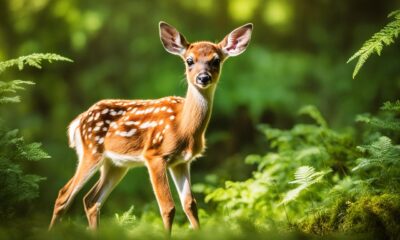
 Deers3 months ago
Deers3 months agoCaring for Baby Deer: Tips for Healthy Fawns
-

 Cats1 month ago
Cats1 month agoCat Weight Chart by Age: Kitten to Senior in Lbs










































